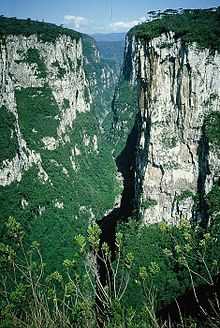Ilha Grande National Park

The Ilha Grande National Park (Parque Nacional de Ilha Grande) is located on the border between Paraná and Mato Grosso do Sul states in Brazil, at 23º24’ S, 53º49’ W.
History
The Ilha Grande National Park was created by decree without number issued by the Presidency of the Republic on 30 September 1997. [2] Currently the park administration rests with the Chico Mendes Institute for Biodiversity Conservation (ICMBio).
Characterization area
The park, with its 78 875 ha in area, encompasses all islands and islets from the Itaipu reservoir and river mouth Piquiri to the mouth of rivers and Amambai Ivaí on the Parana River, among which are the major islands Grande, Peruzzi, Peacock and Bandeirantes. The park area also includes wetlands and flood plains, situated on the banks of the Parana river, lake and lagoon waters and its surroundings and the Seawall Macaws. The river water intended for navigation are not part of the National Park of Ilha Grande. [1] [2]
Ilha Grande protects archaeological sites of great importance. It is known that the site was once inhabited by Guarani Indians and Xetás. [Citation needed] Tourism and attractions
The park is open free to the public for tours every day of the week. The park, in many places, has little beaches, leisure place where you can swim to the banks of the Paraná River. Another option is the boat ride on the Parana River, passing through various localities of Ilha Grande.
Wildlife and vegetation
Ilha Grande is in a transition between cerrado (characteristic of the Pantanal) and seasonal Forest. Already fauna has several endemic species and / or endangered. Among the terrestrial fauna species were recorded as the marsh deer (Blastocelus dichotomus), the alligator-the-crop-yellow (Caiman Latorostris), the jaguar (Panthera onca), tapir (Tapirus terestris) and the giant anteater flag (Myrmecophata trydoctyla). Aquatic fauna include: painted (Pseudoplatystoma corruscans) jaú (Paulicea luetkeni), armed (Pterodoras granular), gold (Salminus maxillosus), pacu (piractus mesopotamicus) and avifauna is cited: jabiru (Jabiru mycteria), jaó (Cryptrellus undulatus), curassow (Crax fasciolata), American spoonbill (Platalea ajaja) and Jacana (Jacana jacana).
